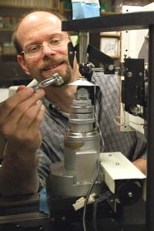CAMBRIDGE, Mass. -- Eighty-five percent of women who inherit mutations in a gene called BRCA develop breast cancer, and 65 percent with the same mutation develop ovarian cancer. Despite intense study, the exact way the gene predisposes patients to breast and ovarian cancer remained a mystery--until now.
MIT researchers report in the Oct. 24 issue of Science a new reason why mutations in the BRCA gene affect a tumor-suppressor protein that plays an important role in repairing damaged DNA.
"Based on the information gained from this newly identified role, we can now begin to understand part of the mechanism for how [the tumor suppressor protein] BRCA1 and a related protein, PTIP, relay the DNA damage signal and how BRCA1 helps control the DNA repair process," said Michael B. Yaffe, associate professor of biology in MIT's Center for Cancer Research and one of the study's authors.
"In addition, we can now use this information to design new anticancer drugs that target the BRCT domain-containing proteins that are found in several proteins, including the tumor suppressor protein BRCA1," he said. "Even though long-term loss of BRCT domain function is bad because it causes cancer, short-term loss can actually be helpful by making tumor cells more sensitive to radiation and chemotherapy," Yaffe said.
Many proteins help repair DNA that's damaged through normal wear and tear as it replicates. Without the protein-to-protein signaling network that marshals the forces of cancer-fighting proteins throughout the body, we would develop tumors far more frequently.
To decipher the precise functions of proteins on a molecular level, Yaffe and colleagues developed a screen to detect the proteins that respond to "911 calls" from damaged DNA. Using this screen, he and biology graduate students Isaac A. Manke and Drew M. Lowery and postdoctoral associate Ahnco Nguyen found that you need two similar chunks of a protein molecule, called BRCT domains, working together to help form protein-repair complexes when DNA is damaged. Loss of the binding function causes cancer because the tumor-suppressing, DNA-repairing proteins are not activated to do this job.
Yaffe works on mapping the signaling networks in protein-to-protein interactions, which go beyond the DNA repair system. Researchers currently understand the functions of only around 10 to 20 percent of the 100,000 proteins in our bodies. Those 100,000 proteins may be involved in only a few hundred vital pathways that control virtually all of our body functions, from stem cells that become organs, bones, muscles, neurons, etc., to cells that cause our bodies to age and die.
Part of what makes this identification task so daunting is that these myriad proteins all talk to each other in complex ways, and some may "pinch hit" for others.
FISHING FOR NEW PROTEIN MODULES
Proteins are made up of modules strung together like beads on a string. When proteins communicate with each other to form multiprotein complexes, the modules on one protein bind to short sequences on other proteins. Often, this type of binding only occurs when the short sequences have been chemically changed by the addition of a phosphate group. A family of enzymes called protein kinases sticks these phosphates on the short sequences in a process called phosphorylation.
Yaffe likened the scenario to a basketball being stuck onto the outside of a building. For a protein, a phosphate group only a few atoms long represents a tiny structural change (as would a basketball stuck on a building), yet it sets into motion a complicated string of events. Only when the phosphate group is present will proteins assemble or change their activity.
Based on this information, Yaffe and colleagues made short separate phosphorylated modules and went fishing. Knowing that kinases determined where to stick the phosphate groups, he chose a set of kinases that are known to deal with cells that have damaged DNA. He found that two similar chunks, or domains, on the BRCA1 and PTIP protein molecules function together as a single module to bind to a specific site. The mutation in the BRCA1 gene that causes cancer disables the ability of the molecule to bind, making BRCA1 incapable of doing its cancer-fighting job.
PINNING DOWN FUNCTION
Yaffe's group has pinpointed and analyzed some 80 snippets of different proteins. "I think our approach is the most direct approach to identifying protein function," he said. Other approaches rely on knocking out a particular protein and observing the result. Even if the result is dramatic, you still don't know exactly what has occurred or why, because so many proteins interact in such complex ways.
"Not only does our approach tell you the biochemical function of a protein molecule, it tells you which proteins are likely to interact with it and the actual mechanism that is likely to be at work. You can use this information to solve the X-ray structure and look, in atomic detail, at how they're working," Yaffe said. Once you know the players in a particular function, you can try to make a drug that would enhance or inhibit its function.
This work is supported by the National Institutes of Health and a Burroughs-Wellcome Career Development Award.






